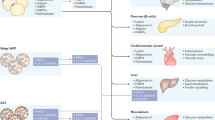Abstract
Catecholamines are the only hormones with pronounced lipolytic action in man. A number of in vivo and in vitro studies suggest that there is lipolytic resistance to catecholamines in subcutaneous adipose tissue, which is the major fat depot in obese subjects. This is due to multiple alterations in catecholamine signal transduction, involving decreased expression and function of β2-adrenoceptors, increased function of α2-adrenoceptors and decreased ability of cyclic monophosphate (AMP) to stimulate hormone sensitive lipase. A sedentary life-style, which usually characterizes obesity, may contribute to the catecholamine resistance. However, hereditary/genetic factors may also be involved. Recently, decreased expression and function of hormone sensitive lipase has been found in subcutaneous adipocytes of non-obese subjects with heredity for obesity. In addition, polymorphisms in the genes for β2-adrenoceptors, β3-adrenoceptors and hormone sensitive lipase, associate with obesity. On the other hand, catecholamine-induced lipolysis in visceral adipose tissue is increased in obesity due to increased function of β3-adrenoceptors (major finding), decreased function of α2-adrenoceptors and increased ability of cyclic AMP to stimulate lipolysis. When the findings in different adipose regions are considered together, it appears that there is a re-distribution of lipolysis and thereby fatty acid mobilization in obesity, favouring the visceral fat depot. This leads to an increase in the circulating fatty acid levels in the portal vein, which connects visceral fat with the liver. As a consequence, the liver function may be altered leading to hyperinsulinemia, hyperglycemia and dyslipidemia, which usually accompany the obese state.
This is a preview of subscription content, access via your institution
Access options
Subscribe to this journal
Receive 12 print issues and online access
$259.00 per year
only $21.58 per issue
Buy this article
- Purchase on Springer Link
- Instant access to full article PDF
Prices may be subject to local taxes which are calculated during checkout
Similar content being viewed by others
Author information
Authors and Affiliations
Rights and permissions
About this article
Cite this article
Arner, P. Catecholamine-induced lipolysis in obesity. Int J Obes 23 (Suppl 1), S10–S13 (1999). https://doi.org/10.1038/sj.ijo.0800789
Published:
Issue Date:
DOI: https://doi.org/10.1038/sj.ijo.0800789
Keywords
This article is cited by
-
Adipocyte p53 coordinates the response to intermittent fasting by regulating adipose tissue immune cell landscape
Nature Communications (2024)
-
Mouse strain-dependent variation in metabolic associated fatty liver disease (MAFLD): a comprehensive resource tool for pre-clinical studies
Scientific Reports (2023)
-
Metabolic and cardiovascular benefits and risks of 4-hydroxy guanabenz hydrochloride: α2-adrenoceptor and trace amine-associated receptor 1 ligand
Pharmacological Reports (2023)
-
Immune and non-immune functions of adipose tissue leukocytes
Nature Reviews Immunology (2022)
-
Playing around the anaerobic threshold during COVID-19 pandemic: advantages and disadvantages of adding bouts of anaerobic work to aerobic activity in physical treatment of individuals with obesity
Acta Diabetologica (2021)



